A Species is the basic rank in biodiversity. The name for a species is treated in Latin and written in italics. Species can also be described as a group of living beings defined by their similarities and family relations in the biological taxonomy.
Below you can find a piece of information about the species selected for this activity.
High pitch: :
1) Robin, Pit-roig, Petirrojo, Robin, Erithacus rubecula
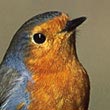 Robin is a common European songbird. It is known for its orange/red breast and head. About 14 cm long, it is tubby and has big head and dark eyes. It frecuently makes its feather stand on end and seems like a little ball. It feeds hopping on the soil. It is a common sight in woodland and wet understorey. In Europe they migrate from North to South to dwell in groves, parks and gardens. It sings a fluting, warbling song during almost the whole year. Robin is a common European songbird. It is known for its orange/red breast and head. About 14 cm long, it is tubby and has big head and dark eyes. It frecuently makes its feather stand on end and seems like a little ball. It feeds hopping on the soil. It is a common sight in woodland and wet understorey. In Europe they migrate from North to South to dwell in groves, parks and gardens. It sings a fluting, warbling song during almost the whole year.
2) Blue Tit, Mallerenga blava, Herrerillo común, Blue Tit, Parus caeruleus
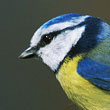 Blue tit is a small bird, about 11 cm long, easily recognisable from other birds of this size due to its blue and yellow colouring and lively behaviour. They live in woodland, especially in deciduous, as well as in parks and gardens. They breed in any suitable hole of a tree or an artificial nest box.They feed on caterpillars and insects, although in winter, when these are scarce, they also eat seeds. It is not common to hear them in summer but in September they start to move from tree to tree looking for insects and calling other individuals. Their mating song period begins in late wintert. Blue tit is a small bird, about 11 cm long, easily recognisable from other birds of this size due to its blue and yellow colouring and lively behaviour. They live in woodland, especially in deciduous, as well as in parks and gardens. They breed in any suitable hole of a tree or an artificial nest box.They feed on caterpillars and insects, although in winter, when these are scarce, they also eat seeds. It is not common to hear them in summer but in September they start to move from tree to tree looking for insects and calling other individuals. Their mating song period begins in late wintert.
Low pitch:
3) Raven, Corb, Cuervo, Raven, Corvus corax
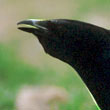 Black bird of about 60 cm in length. Their bill is large and slightly curved and their constitution is strong. They like wide open spaces such as desserts, plains or lonely territories but they also live in woodland, especially in mountain forests. In the late winter they nest in cliffs, rocks, trees or even ruins and usually live and travel in mated pairs. Ravens have shown great inteligence and some remarkable feats of problem-solving have been observed in the species. They can also mimic sounds from their environment. They are fed on insects, worms and beettles. Black bird of about 60 cm in length. Their bill is large and slightly curved and their constitution is strong. They like wide open spaces such as desserts, plains or lonely territories but they also live in woodland, especially in mountain forests. In the late winter they nest in cliffs, rocks, trees or even ruins and usually live and travel in mated pairs. Ravens have shown great inteligence and some remarkable feats of problem-solving have been observed in the species. They can also mimic sounds from their environment. They are fed on insects, worms and beettles.
4) Eagle Owl, Duc, Búho real, Eagle Owl, Bubo bubo
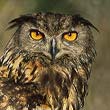 Owl is the largest nocturnal bird up to 70 cm in length. It is brown and has large forward-facing “ears”. It is found in forests with rocky areas, usually nesting on cliff ledges. In spite of it size it goes unnoticed. This sedentary bird mainly feeds on mammals and small birds and starts breeding in cold winter nights. Owl is the largest nocturnal bird up to 70 cm in length. It is brown and has large forward-facing “ears”. It is found in forests with rocky areas, usually nesting on cliff ledges. In spite of it size it goes unnoticed. This sedentary bird mainly feeds on mammals and small birds and starts breeding in cold winter nights.
Rhythmic song:
5) Hoopoe, Puput, Abubilla, Hoopoe, Upupa epops
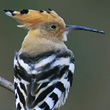 Hoopoe is a bright and colourful 27 cm long bird. It is notable for its distinctive 'crown' of long black feathers which uses when it is excited and in mating ritual by breeding them and tilting its head up. The length of their bill allows it to probe the ground, where it tipically feeds from worms, caterpillars, insects, butterflies, ants and flies. It frecuently pokes around in the manure and its nest has a foul-smelling, thougth to deter predators. Migration starts in late winter from Africa to Europe and repeats in midsummer. Hoopoe is a bright and colourful 27 cm long bird. It is notable for its distinctive 'crown' of long black feathers which uses when it is excited and in mating ritual by breeding them and tilting its head up. The length of their bill allows it to probe the ground, where it tipically feeds from worms, caterpillars, insects, butterflies, ants and flies. It frecuently pokes around in the manure and its nest has a foul-smelling, thougth to deter predators. Migration starts in late winter from Africa to Europe and repeats in midsummer.
6) Red-legged Partridge, Perdiu, Perdiz, Red-legged Partridge, Alectoris rufa
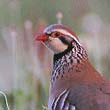 Red-legged Partridge, about 35 cm in length, is widespread in Mediterranean countries. This species breeds on dry lowlands, such as farmland and open stony areas. Male starts to be in rut in January and builds sevelar nests among which female choses one, breeding in it between April and May. It is a non-migratory terrestrial species which forms flocks outside the breeding season. It prefers to run rather than fly, but if necessary it flies a short distance. Male individuals can spend a long time calling females. Red-legged Partridge, about 35 cm in length, is widespread in Mediterranean countries. This species breeds on dry lowlands, such as farmland and open stony areas. Male starts to be in rut in January and builds sevelar nests among which female choses one, breeding in it between April and May. It is a non-migratory terrestrial species which forms flocks outside the breeding season. It prefers to run rather than fly, but if necessary it flies a short distance. Male individuals can spend a long time calling females.
Melodic song:
7) Blackbird, Merla, Mirlo, Blackbird, Turdus merula
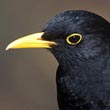 It is common in woods and gardens over all of Europe (it is the European member of the thrush family Turdidae). It is more than a span in length and while male is all black except for a yellow eye-ring and bill, female birds have brown plumage. It is a lively and worked up bird but also timid, flying away with a guffaw when it is disturbed. It buils its clean nest with weeds and dry leaves. They are omnivorous, eating a wide range of insects, earthworms and seeds. The male sings varied and melodious songs. It is common in woods and gardens over all of Europe (it is the European member of the thrush family Turdidae). It is more than a span in length and while male is all black except for a yellow eye-ring and bill, female birds have brown plumage. It is a lively and worked up bird but also timid, flying away with a guffaw when it is disturbed. It buils its clean nest with weeds and dry leaves. They are omnivorous, eating a wide range of insects, earthworms and seeds. The male sings varied and melodious songs.
8) Great Tit, Mallerenga carbonera, Carbonero común, Great Tit, Parus major
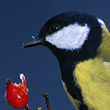 Great Tit is a forest and insectivore bird for which any hole will do for a nest. It is an easy tit to watch as it is very active and can be seen eating insects among the branches, but it is also easy to recognise for its broad black line down its otherwise yellow front. Its song is audible in the early morning, when individuals of the species reply each other. Great Tit is a forest and insectivore bird for which any hole will do for a nest. It is an easy tit to watch as it is very active and can be seen eating insects among the branches, but it is also easy to recognise for its broad black line down its otherwise yellow front. Its song is audible in the early morning, when individuals of the species reply each other.
For further information:
http://www.mangoverde.com/birdsound
http://www.islapro.com/ecologia/avium/ferrarico.htm (incubation period)
http://www.birding.com/species.asp
http://avianweb.com/birdspecies.htm
http://www.allaboutbirds.org/guide/search
|

 Robin is a common European songbird. It is known for its orange/red breast and head. About 14 cm long, it is tubby and has big head and dark eyes. It frecuently makes its feather stand on end and seems like a little ball. It feeds hopping on the soil. It is a common sight in woodland and wet understorey. In Europe they migrate from North to South to dwell in groves, parks and gardens. It sings a fluting, warbling song during almost the whole year.
Robin is a common European songbird. It is known for its orange/red breast and head. About 14 cm long, it is tubby and has big head and dark eyes. It frecuently makes its feather stand on end and seems like a little ball. It feeds hopping on the soil. It is a common sight in woodland and wet understorey. In Europe they migrate from North to South to dwell in groves, parks and gardens. It sings a fluting, warbling song during almost the whole year.  Blue tit is a small bird, about 11 cm long, easily recognisable from other birds of this size due to its blue and yellow colouring and lively behaviour. They live in woodland, especially in deciduous, as well as in parks and gardens. They breed in any suitable hole of a tree or an artificial nest box.They feed on caterpillars and insects, although in winter, when these are scarce, they also eat seeds. It is not common to hear them in summer but in September they start to move from tree to tree looking for insects and calling other individuals. Their mating song period begins in late wintert.
Blue tit is a small bird, about 11 cm long, easily recognisable from other birds of this size due to its blue and yellow colouring and lively behaviour. They live in woodland, especially in deciduous, as well as in parks and gardens. They breed in any suitable hole of a tree or an artificial nest box.They feed on caterpillars and insects, although in winter, when these are scarce, they also eat seeds. It is not common to hear them in summer but in September they start to move from tree to tree looking for insects and calling other individuals. Their mating song period begins in late wintert.  Black bird of about 60 cm in length. Their bill is large and slightly curved and their constitution is strong. They like wide open spaces such as desserts, plains or lonely territories but they also live in woodland, especially in mountain forests. In the late winter they nest in cliffs, rocks, trees or even ruins and usually live and travel in mated pairs. Ravens have shown great inteligence and some remarkable feats of problem-solving have been observed in the species. They can also mimic sounds from their environment. They are fed on insects, worms and beettles.
Black bird of about 60 cm in length. Their bill is large and slightly curved and their constitution is strong. They like wide open spaces such as desserts, plains or lonely territories but they also live in woodland, especially in mountain forests. In the late winter they nest in cliffs, rocks, trees or even ruins and usually live and travel in mated pairs. Ravens have shown great inteligence and some remarkable feats of problem-solving have been observed in the species. They can also mimic sounds from their environment. They are fed on insects, worms and beettles.  Owl is the largest nocturnal bird up to 70 cm in length. It is brown and has large forward-facing “ears”. It is found in forests with rocky areas, usually nesting on cliff ledges. In spite of it size it goes unnoticed. This sedentary bird mainly feeds on mammals and small birds and starts breeding in cold winter nights.
Owl is the largest nocturnal bird up to 70 cm in length. It is brown and has large forward-facing “ears”. It is found in forests with rocky areas, usually nesting on cliff ledges. In spite of it size it goes unnoticed. This sedentary bird mainly feeds on mammals and small birds and starts breeding in cold winter nights.  Hoopoe is a bright and colourful 27 cm long bird. It is notable for its distinctive 'crown' of long black feathers which uses when it is excited and in mating ritual by breeding them and tilting its head up. The length of their bill allows it to probe the ground, where it tipically feeds from worms, caterpillars, insects, butterflies, ants and flies. It frecuently pokes around in the manure and its nest has a foul-smelling, thougth to deter predators. Migration starts in late winter from Africa to Europe and repeats in midsummer.
Hoopoe is a bright and colourful 27 cm long bird. It is notable for its distinctive 'crown' of long black feathers which uses when it is excited and in mating ritual by breeding them and tilting its head up. The length of their bill allows it to probe the ground, where it tipically feeds from worms, caterpillars, insects, butterflies, ants and flies. It frecuently pokes around in the manure and its nest has a foul-smelling, thougth to deter predators. Migration starts in late winter from Africa to Europe and repeats in midsummer. Red-legged Partridge, about 35 cm in length, is widespread in Mediterranean countries. This species breeds on dry lowlands, such as farmland and open stony areas. Male starts to be in rut in January and builds sevelar nests among which female choses one, breeding in it between April and May. It is a non-migratory terrestrial species which forms flocks outside the breeding season. It prefers to run rather than fly, but if necessary it flies a short distance. Male individuals can spend a long time calling females.
Red-legged Partridge, about 35 cm in length, is widespread in Mediterranean countries. This species breeds on dry lowlands, such as farmland and open stony areas. Male starts to be in rut in January and builds sevelar nests among which female choses one, breeding in it between April and May. It is a non-migratory terrestrial species which forms flocks outside the breeding season. It prefers to run rather than fly, but if necessary it flies a short distance. Male individuals can spend a long time calling females.  It is common in woods and gardens over all of Europe (it is the European member of the thrush family Turdidae). It is more than a span in length and while male is all black except for a yellow eye-ring and bill, female birds have brown plumage. It is a lively and worked up bird but also timid, flying away with a guffaw when it is disturbed. It buils its clean nest with weeds and dry leaves. They are omnivorous, eating a wide range of insects, earthworms and seeds. The male sings varied and melodious songs.
It is common in woods and gardens over all of Europe (it is the European member of the thrush family Turdidae). It is more than a span in length and while male is all black except for a yellow eye-ring and bill, female birds have brown plumage. It is a lively and worked up bird but also timid, flying away with a guffaw when it is disturbed. It buils its clean nest with weeds and dry leaves. They are omnivorous, eating a wide range of insects, earthworms and seeds. The male sings varied and melodious songs.  Great Tit is a forest and insectivore bird for which any hole will do for a nest. It is an easy tit to watch as it is very active and can be seen eating insects among the branches, but it is also easy to recognise for its broad black line down its otherwise yellow front. Its song is audible in the early morning, when individuals of the species reply each other.
Great Tit is a forest and insectivore bird for which any hole will do for a nest. It is an easy tit to watch as it is very active and can be seen eating insects among the branches, but it is also easy to recognise for its broad black line down its otherwise yellow front. Its song is audible in the early morning, when individuals of the species reply each other.